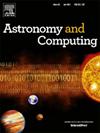Real-bogus scores for active anomaly detection
IF 1.8
4区 物理与天体物理
Q2 ASTRONOMY & ASTROPHYSICS
引用次数: 0
Abstract
In the task of anomaly detection in modern time-domain photometric surveys, the primary goal is to identify astrophysically interesting, rare, and unusual objects among a large volume of data. Unfortunately, artifacts — such as plane or satellite tracks, bad columns on CCDs, and ghosts — often constitute significant contaminants in results from anomaly detection analysis. In such contexts, the Active Anomaly Discovery (AAD) algorithm allows tailoring the output of anomaly detection pipelines according to what the expert judges to be scientifically interesting. We demonstrate how the introduction real-bogus scores, obtained from a machine learning classifier, improves the results from AAD. Using labeled data from the SNAD ZTF knowledge database, we train four real-bogus classifiers: XGBoost, CatBoost, Random Forest, and Extremely Randomized Trees. All the models perform real-bogus classification with similar effectiveness, achieving ROC-AUC scores ranging from 0.93 to 0.95. Consequently, we select the Random Forest model as the main model due to its simplicity and interpretability. The Random Forest classifier is applied to 67 million light curves from ZTF DR17. The output real-bogus score is used as an additional feature for two anomaly detection algorithms: static Isolation Forest and AAD. The number of artifacts detected by both algorithms decreases significantly with the inclusion of the real-bogus score in cases where the feature space regions are densely populated with artifacts. However, it remains almost unchanged in scenarios where the overall number of artifacts in the outputs is already small. We conclude that incorporating the real-bogus classifier result as an additional feature in the active anomaly detection pipeline reduces the number of artifacts in the outputs, thereby increasing the incidence of astrophysically interesting objects presented to human experts.
用于主动异常检测的真假分数
在现代时域光度测量中的异常检测任务中,主要目标是从大量数据中识别出天体物理上有趣的、罕见的和不寻常的物体。不幸的是,伪影——例如飞机或卫星轨迹、ccd上的坏列和鬼影——通常会在异常检测分析的结果中构成重要的污染物。在这种情况下,主动异常发现(AAD)算法允许根据专家判断的科学兴趣定制异常检测管道的输出。我们演示了从机器学习分类器获得的引入真假分数如何改善AAD的结果。使用来自SNAD ZTF知识库的标记数据,我们训练了四个真实的伪分类器:XGBoost、CatBoost、Random Forest和extreme Randomized Trees。所有模型都以相似的有效性进行真伪分类,ROC-AUC得分在0.93到0.95之间。因此,我们选择随机森林模型作为主要模型,因为它的简单性和可解释性。随机森林分类器应用于来自ZTF DR17的6700万条光曲线。输出的真伪分数被用作两种异常检测算法的附加特征:静态隔离森林和AAD。在特征空间区域被伪信号密集地填充的情况下,两种算法检测到的伪信号数量都随着真伪分数的加入而显著减少。然而,在输出中的工件总数已经很小的场景中,它几乎保持不变。我们的结论是,将真伪分类器结果作为主动异常检测管道中的附加特征,减少了输出中的伪制品数量,从而增加了向人类专家呈现天体物理上有趣物体的发生率。
本文章由计算机程序翻译,如有差异,请以英文原文为准。
求助全文
约1分钟内获得全文
求助全文
来源期刊

Astronomy and Computing
ASTRONOMY & ASTROPHYSICSCOMPUTER SCIENCE,-COMPUTER SCIENCE, INTERDISCIPLINARY APPLICATIONS
CiteScore
4.10
自引率
8.00%
发文量
67
期刊介绍:
Astronomy and Computing is a peer-reviewed journal that focuses on the broad area between astronomy, computer science and information technology. The journal aims to publish the work of scientists and (software) engineers in all aspects of astronomical computing, including the collection, analysis, reduction, visualisation, preservation and dissemination of data, and the development of astronomical software and simulations. The journal covers applications for academic computer science techniques to astronomy, as well as novel applications of information technologies within astronomy.
 求助内容:
求助内容: 应助结果提醒方式:
应助结果提醒方式:


